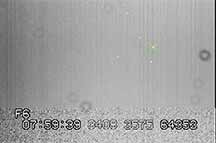


This event has a mediocre rank. Each of Karl, Kirk and I have about a 36% chance of a hit. Karl's north of the centerline, Kirk and I are south. 11.8 is normally easy to see, but 4 degrees away from a moon just 2 days past full, will be a bright sky at only 20 degrees altitude. Skies are dry and clean tonight. Maybe we'll be OK.
There's a 9.7 mag star between two 10th mag stars that should provide a decent thing to aim for, near the target and above/right of it, on the video frames.
 |
 |
 |
This was a much tougher occultation than we thought. The sky brightness goes up very sharply as you get closer to a big moon. I could see the gradient in brightness even across the 1/4 degree width of the LCD field. Kirk couldn't see any stars even at 2x - it was too bright. Karl was the same story. I could see the bright 10th magnitude triplet at upper right of the target, and the 8SE scope pointing was spot on. I took care, using Deneb and Antares for my alignment stars, and was careful to approach the alignment stars to the center of the eyepiece from the same direction for both stars. Then, when I went to the target, there was no gear take-up to cause mis-pointing. I could barely see anything in the eyepiece, but the 9.7 mag star was faintly visible and I assumed it was the right one, confirmed when I put in the Watec. I could not see the target star at all, but hoped I could "fix it in post".
My first attempt was standard procedure: Make a 222 frame "finder" (shown at bottom below), on which the target star was clearly visible. But I had to keep the Watec at 2x, because 4x was a total white-out. At 2x, on the light curve you could see the light curve of the target, barely above sky on average. Not well enough to make much judgement since if there was an event it would likely be only 2-3 seconds. I then decided what I'd do is make a series of "finders" lasting 50 frames or 1.5s integrations. The nice thing about 'finders' is that they are averages, not sums, so the noise goes away and dim stars are still visible above the sky after a contrast adjustment in PyMovie. I made a series of them all at the same settings and show them below...
I can see the target star on each frame, and each image is 1.5s of data. Looks like a miss. Here's where the target is...
|
A 50 frame "finder" from PyMovie. The target is labelled. Dust donuts I didn't know I had are also evident. I got a squeeze bulb and blew them off later. |
And here's my sequence of "finders" showing the target star on all of them, chronologically, centered on the predicted occultation time.
 |
 |
 |
 |
 |
 |
 |
 |
 |
 |
 |
 |
 |
 |
 |
 |
 |
 |
 |
 |
 |
Below... In the PyOTE light curve, the dark blue (target) curve is barely above the sky (light blue) and not enough to detect an occultation, and the software could not read the digits from the too-bright screen, although presumably a new PyMovie training would have solved that. Instead, by stepping through with the 50 frame (1.66s) "finders" and deciding if I can see the target or not, more convincingly shows a miss. This is a new option for handling difficult events of this kind against a bright sky, which might be worth incorporating into the software to extract timings.
|
The light curve. Note that the bright sky prevented ID'ing the time stamps. Dark blue is the target, light blue is the blank sky, red is the 9.7 tracking star. |
A single frame, even after adjusting brightness and contrast reasonably for S/N. Adjusting the sky to be darker like at right, did not pull out the target star. The speckles are brighter than the target star. No hint of the target here. Not usable as is. |
A 222 frame 'finder' (6.66 sec) clearly shows the target, after adjusting brightness and contrast |